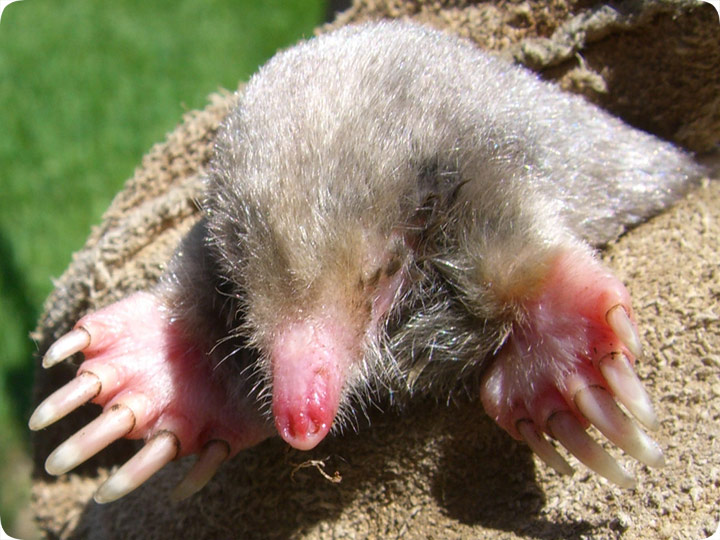-
info@aaanimalcontrol.com
Call us for help in your town
Humane Wildlife Education
Eastern Mole Control

06.06.2004 - The Eastern Mole (Scalopus aquaticus) is common throughout most of the eastern United States, from Canada all through Florida. This little critter only grows to about 6.5 inches in total length, and 3 oz. in weight. It has no ears or eyes,
as you can see in the above photo, but it may be able to detect light. Moles, of course, live underground, where they dig a network of tunnels. They burrow through the soil in search of earthworms and grubs, and they can dig very quickly. They are very energetic, and
they eat a lot, about half of their body weight each day. They are territorial, and probably don't live much longer than two years in the wild.
I caught the above mole at a customer's house. Her yard was filled with raised tunnels and mole hills, and she didn't want any more lawn destruction. Because moles are territorial, the removal of just one mole from an average sized yard usually stops the digging. I set
Victor mole traps at several of the key surface tunnels, and caught the mole within three days. The trick is to set the trap in tunnels that are actively used. Moles sometimes dig tunnels that they use only once, for feeding. However, other tunnels are used repeatedly
for travel between different feeding areas or burrows. These tunnels tend to be longer and straighter. Also, tunnels positioned along barriers, such as the edge of a house, tend to be used repeatedly, and are good bets. Mole control, like many types of wildlife control,
is not easy, and people with experience will of course have the highest success rate. I do now regret stating that "AAAnimal Control will roll that moll out of its hole", because it's more of a tunnel, not a hole, and it's more of a trapping than a rolling. But I wrote it,
and so now there's nothing I can do. People call me and demand that I roll their moles out of their holes, and I must comply.
Do it yourself: Visit my How To Get Rid of Animal Moles page for tips and advice.
Get professional help: Visit my Nationwide Pro Directory of wildlife removal experts.
For more wildlife stories, click my Wildlife Blog
or click my below banner to hire a local trapper.
Moles are mammals that live underground and eat invertebrates such as earthworms and grubs that reside in the soil. They are carnivores and don't eat plants or anything of that sort due to their dental structure which limits their eating and chewing.
It can be quite frustrating for homeowners who spend a lot of time and effort on their landscape and then later discover it torn up by moles. It is important to curb their movements when it comes to protecting one's interests. People have come up with different ways to stop their movements and progress. Some have shown major impacts while others had little to no effect. Some of these measures are discussed below.
Predation can be used to control eastern moles. It can be quite helpful if these moles are active and have not moved into deep soil. If there is a predator who's efficient and motivated, it can help a lot. Some breeds of dogs are skilled at digging especially when it comes to moles. The trick is to do this when moles are active which can be up to three times a day. So, a terrier dog can be used to catch these moles when they are active. If the moles are found, they can be discarded using a shovel but this is usually not preferred and that is the reason why people opt for trapping.
Controlling moles by trapping them is the most preferred method amongst people. Trapping has proved to be effective throughout the years because moles use tunnels to travel and transport food and hence, these tunnels are kept open. The same openness and access to tunnels are what aids in trapping them. These traps are placed with a hindrance to the moles in their main tunnel. It is to be noted that these traps should only be placed where moles are active and can be caught within the next 36 hours. If it is placed in a tunnel that is hardly used, the method will eventually fail.
There are many traps available and you can read the directions and procedures that are included with the traps to get a better understanding of how they work. The first step involves selecting an appropriate tunnel. Once you have done that, choose a scissor-type trap and place it in the tunnel. Make space by taking out the soil and then add a hindrance that is tall and goes up high. Make sure it reaches the trigger of the scissor trap. Then, put the trap on the obstruction. To avoid the moles getting scared, the trick is to use a bucket so the airflow doesn't drive them away. Simultaneously, it protects the soil against saturation.
The above two methods are bound to solve your problem, however, stay away from the ones that promise to get rid of moles but don't deliver effective results such as:
1.Sonic repellants
2.Gassing
3.Chemical repellants




















